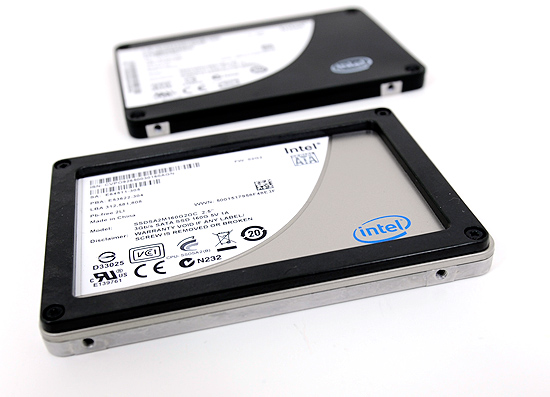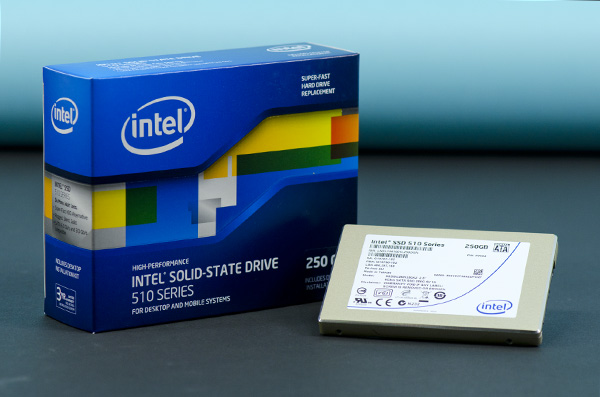The Intel SSD 510 Review
by Anand Lal Shimpi on March 2, 2011 1:23 AM EST- Posted in
- IT Computing
- Storage
- SSDs
- Intel
- Intel SSD 510
The X25-M was a tremendous first attempt by Intel to get into the SSD market. In our review of the SSD I wrote that Intel just Conroe’d the SSD market, and if it weren’t for the pesky 80MB/s sequential write speed limitation the X25-M would’ve been given the title: World’s Fastest Drive.

Its successor, the X25-M G2, was a mild update that brought prices down through the use of 34nm NAND. Remember that Intel is also 49% owner of the IMFT joint venture and as a result can be quite competitive on NAND pricing (and quite early to adopt new NAND technologies).

Intel’s goal all along was to drive down the cost of SSDs. Looking at the history of MSRPs with the X25-M (not to mention the M, which stood for Mainstream in the product name) this shouldn’t come as a surprise:
| Intel X25-M Pricing History | |||||
| 2008 | 2009 | ||||
| 40GB | - | $125 | |||
| 80GB | $595 | $225 | |||
| 160GB | $1000+ | $440 | |||
The third generation X25-M was to drive down costs even further, this time thanks to Intel’s 25nm NAND. You’d be able to get twice the capacity at the same price point as the X25-M G2. The value drive would be an 80GB offering, the mainstream drive would be 160GB and the high end drive would be 320GB.
The drive would offer higher performance. The controller was to be completely redesigned, with the “oversight” that limited sequential write speed to only 100MB/s corrected entirely. In addition, the third generation Intel SSD would add full disk encryption - making it even better suited for enterprise customers. Going after the enterprise market was Intel’s plan to really make money on SSDs in the long run. Instead of just selling corporations a CPU, chipset and wireless controller in a notebook, there would be an SSD on top of all of that. Perhaps eventually even have some security software courtesy of McAfee.
The third generation X25-M was originally due out in the middle of 2010. As is usually the case with schedules, the “G3” slipped. The middle of the year became the end of the year and the end of the year became Q1 2011.
To make matters worse, the specifications Intel was talking about for its third generation drive/controller weren’t all that competitive. We published the details last year knowing that the competition would do better. Intel’s redesigned controller was late and underperforming. Internally, Intel knew it had a problem.
Intel aimed for the majority of the market with the X25-M, it had set its sights on lowering cost, but it left the high performance enthusiast market entirely uncared for. A void that SandForce filled quite nicely with its unique brand of controllers.
With a hole in the roadmap and an unwillingness to cede complete control of the high end market to SandForce, Intel did the unthinkable: developed a new SSD based on a competing controller technology.











128 Comments
View All Comments
Golgatha - Wednesday, March 2, 2011 - link
I'd also like to add that you will however most certainly notice the difference of 3.15MB/s of random R/W performance my RAID0 Velociraptors put out versus the random R/W performance of pretty much any SSD. SSDs make a huge amount of sense as an OS and applications drive.
EddyKilowatt - Wednesday, March 2, 2011 - link
"...the last thing SSDs are lacking is speed..."Amen. Ninety percent of us still have 3 GB SATA and are just waiting for the 25 nm devices to do their thing to the $/GB on more prosaic drives
mgl888 - Wednesday, March 2, 2011 - link
I had high expectations from Intel.. now I'm a little disappointed.As the article said, random read is MOST important for a boot drive. Surely Intel should know this?
critical_ - Wednesday, March 2, 2011 - link
I'm not sure I agree.1. The SSD market still has a lot of growth ahead of it. Price per GB is the current issue and may be the new "performance per watt" buzz word in this space. Case in point, when I can grab a cheap Dell server for $350 and average notebooks are advertised everyday for $300-$600, are people really going to spend $300-$600+ on an SSD? If it was a much cheaper option then many would go with it.
2. Synthetic vs. Real-world. Synthetic benchmarks are great for bragging on the various overclocking forums but most of us get work done in the real-world. This is no different than people who tune cars for 1/4 mile races but must transport the car on a flat-bed carrier. For some this is a perfectly great trade-off for bragging rights but many of us prefer to get 90% of the 1/4 mile performance and be able to drive the car back and forth to a weekend outing. My point is that in real-world benchmarks there may be some minor deficiencies but will 95% of users notice? I doubt it.
3. I put an Intel X-25M G2 160GB SSD in my father's quad-core desktop that he uses for Photoshop work after listening to many months of complaints that his system was too slow. After the swap, he loves the performance and I love the fact that I'm no longer fielding "it's too slow" complaints. This was the best money I've spent in recent memory but the price is still an issue for most people.
4. Would a user like my father noticed a difference between the X-25M and either a 510 or Vertex 3? I doubt it. Besides we'd have to get him a SATA3 motherboard or an add-in card. Again, it's a price issue.
5. Not too long ago the must-have upgrade was adding RAM to a Windows machine. These days 3-8GB systems are almost the norm so the must-have upgrade is an SSD if a user can stomach the cost. Head on over to NewEgg and read the reviews of "value" SSDs and you'll get an idea of the disappointment for some people who transitioned from HDDs to SSDs in both desktops and laptops. The drives in this segment aren't changing the user experience as dramatically as those ponying up for the high-end devices. Then there is the issue of lack of TRIM support, 4K issues, firmware upgrades destroying data, and the list goes on. The segment needs to addressed by Intel.
6. Finally, hybrids. We see the Intel Z68 will support SSD caching along with higher-end stuff from Adaptec or HighPoint's RocketHybrid controllers trying to get the best of both SSDs and HDDs. Could this be a game-changer? Possibly.
The points that I'm making come down to both real-world performance and market segments. The SSD market would benefit from a better stragety on the entry-level and mid-range markets the way ATI and nVidia have done things. Whoever brings the price down to grab the majority of users will eventually win a good chunk of business. With all that aside, as it stands the 510 is fine for the types of loads I'd put on an SSD as a power user so I'm happy to trade a bit of real-world performance for Intel's reliability.
landerf - Wednesday, March 2, 2011 - link
Well that was disappointing. Unless intel prices themselves under OCZ they may do very poorly with this drive.semo - Wednesday, March 2, 2011 - link
The sad thing is that they won't. They always have their "conroe" moment and then they sink up their product in the next generations but they still come out ahead. Even their Prescott cores did very well when they shouldn't have.vol7ron - Wednesday, March 2, 2011 - link
Yeah that was my fault. I shouldn't have bought a Prescottm.amitava - Wednesday, March 2, 2011 - link
I am really the biggest fan of Anand and his team (used to bypass my company firewall and risk losing my job just to read all the stuff here..) but it does seem like Anand is trying to smooth over the 510's seriously non-competitive random performance....IMO it showed badly enough that I finally decided to sign up and post a comment...
I hope I am mistaken...
Sigwulff - Wednesday, March 2, 2011 - link
Well isn't it the old debate regarding synthetic vs. real-world tests? I'll admit it looked bleak for the random parts, but looking at the heavy and light workload 510 looked somewhat shinier...I was 100% sure on the Vertex 3, but presently I'll have to wait and see about the pricing when it lands here in little Denmark :-)
Btw, mentioning the bundle you completely overlooked the very nice cabinet sticker Intel included. I would like some tests about glue adherency, how envious your friends look when they see the sticker on your pc-cabinet etc. :-)
ok just kidding, very nice and informative review! (why we love Anand so much :-)
semo - Wednesday, March 2, 2011 - link
+1I'm still disappointed that Anand hasn't covered the OCZ Vertex 2 "25nm version" con. This is a consumer rights issue and should take precedence over any other development of a technical nature.